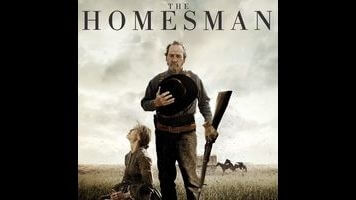Integrity and personality can go a long way, especially in a movie as unquestionably flawed as The Homesman. Tommy Lee Jones’ off-beat minor-key Western has plenty of virtues, but straightness isn’t one of them; at times, it seems like the movie is doing its goshdarnedest to stay crooked, resisting every opportunity to smooth itself out. It trades in unresolved themes, unexplained motifs, and abrupt bursts of violence, meandering its way to a fittingly inscrutable final image of Jones’ character, a drifter who calls himself George Briggs, dancing a jig for no one in particular.
The bulk of The Homesman covers a months-long journey across the Nebraska Territory, undertaken by Cuddy and Briggs to transport three mentally ill women—Gro Svendsen (Sonja Richter), Theoline Belknap (Miranda Otto), and Arabella Sours (Grace Gummer)—from the frontier community of Loup to the care of a Methodist minister in Hebron, Iowa. Cuddy, past 30 and living “uncommonly alone,” has rescued Briggs—whose real name is unknown—from the noose of a vigilante mob, and hired him for the trip in exchange for a jug of whiskey and $300 in bank notes. Their charges are the wives of farmers, dragged out West with the promise of fresh soil and driven mad by its hardships. Arabella, all of 19, has already buried three children, and is now barely verbal, fixated on caring for a rag doll; Gro, unable to get pregnant, is covered in self-inflicted cuts; Theoline, broken by a brutal cycle of farm work and nursing, has drowned her newborn in the pit of an outhouse.
The notion of the West as a wasteland of death and madness is classic acid Western stuff, but The Homesman—which was adapted from a novel by Glendon Swarthout, author of The Shootist—is doggedly realist, directed in that handsome, straight-shooting Clint Eastwood mode, where every interior is intentionally underlit and every role is deliberately underplayed. Party politics aside, Jones and Eastwood have a lot in common: Both are actor-directors with an interest in the mythology of the West, and both make movies about men who have to render themselves obsolete in order to make a slightly better world. The Homesman could easily be an Eastwood movie; it certainly looks like one.
And like quite a few of the later Eastwood movies, The Homesman is uneven and more than a little scattered in ways that are admirable, its flaws the result of a refusal to clean up what is perhaps best left untidied. It’s at times two-thirds of a feminist Western, and then two-thirds of a black comedy, and even two-thirds of a badman-done-right movie; in every case, it’s missing some crucial piece, usually an ending, that would render it completely satisfying.
Jones’ pet subjects are loneliness and the way in which death forces people to shift their sense of responsibility—themes he previously explored in The Three Burials Of Melquiades Estrada and his made-for-HBO Cormac McCarthy adaptation The Sunset Limited. In the former, he plays a rancher who sets out to Mexico to bury his closest friend, an illegal migrant worker, bringing along the border patrolman who killed him as a hostage. In the latter, he was a depressed intellectual who’d been pulled from a suicide attempt. Here, he’s a yawping jackass, scraping by in an inhospitable landscape of bare skies and chilled earth tones. Toward the end, he finds himself in the position of being perceived as a good and selfless man, but can’t seem to derive any satisfaction from it. This is a vision of the frontier as an unsatisfying place that draws in unsatisfied people. How long you last depends on how willing you are to live hopelessly.

 Keep scrolling for more great stories.
Keep scrolling for more great stories.
